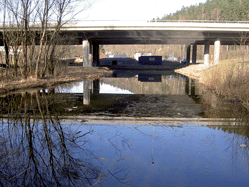The ecotoxicological impact of highway runoff on brown trout (Salmo trutta L.) was studied in an in situ experiment consisting of four 24 h simulated runoff episodes. Fish were maintained in 5 tanks and exposed to highway runoff from a sedimentation pond close to E6 outside the city of Oslo, Norway. The tanks had the following contaminant loadings during the episodes: stream water (control), pond inlet, pond outlet, pond inlet + stream water and pond outlet + stream water. Opposite to road salt and compared to earlier findings, the first two episodes had rather low concentrations of trace metals, hydrocarbons and polycyclic aromatic hydrocarbons. A heavy rainfall before episode 3 increased the concentrations of all the contaminants except road salt which was diluted. In addition, lowered oxygen levels led to hypoxic conditions. Overall the fish exposed to highway runoff had, compared to the control fish, higher concentrations of trace metals in gills and liver, increased activity of the antioxidant defense system represented by superoxide dismutase, catalase and metallothionein, problems with the regulation of plasma Cl and Na, as well as increased levels of blood glucose and pCO2. Finally, this seemed to affect the metabolism of the fish through reduced condition factor. The observed effects were likely caused by multiple stressors and not by a single contaminant. The sedimentation pond clearly reduced the toxicity of the highway runoff. But even in the least polluted exposure tank (pond outlet + stream water) signs of physiological disturbances were evident.

You have access to this article
 Please wait while we load your content...
Something went wrong. Try again?
Please wait while we load your content...
Something went wrong. Try again?


 Please wait while we load your content...
Please wait while we load your content...